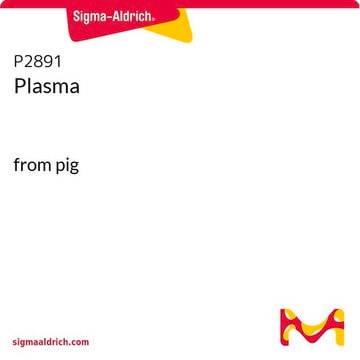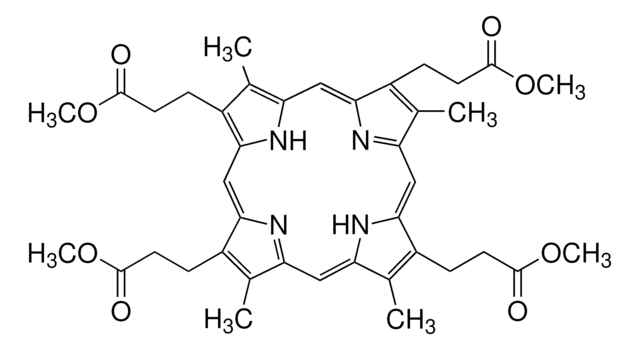Recommended Products
biological source
bovine
Quality Level
form
powder
contains
3.8% trisodium citrate as anticoagulant
storage temp.
2-8°C
Looking for similar products? Visit Product Comparison Guide
General description
Plasma is the liquid part of the blood and lymphatic fluid, which makes up about half of its volume. Plasma is devoid of cells and, unlike serum, has not clotted. Some of the more common proteins found in plasma are albumin and prealbumin, α1-acid glycoprotein, transferrin, lipoproteins (HDL, LDL, and VLDL), immunoglobulins, complement proteins, and coagulation proteins (thrombin, plasminogin, and fibrinogen). Citrated plasma contains citrate (3.8% trisodium citrate) as an anticoagulant.
Plasma contains a variety of proteins with diverse functions. The primary functions of the plasma proteins include the maintenance of colloid osmotic pressure, pH, and electrolyte balance; the transport of metal ions, fatty acids, steroids, hormones, and drugs to various organs of the body; use as a source for amino acids for tissue nourishment; hemostasis and the prevention of thrombosis; the regulation of cellular activity and function through hormone signaling; and defense against invasion through the actions of antibodies and complement components.
Plasma contains a variety of proteins with diverse functions. The primary functions of the plasma proteins include the maintenance of colloid osmotic pressure, pH, and electrolyte balance; the transport of metal ions, fatty acids, steroids, hormones, and drugs to various organs of the body; use as a source for amino acids for tissue nourishment; hemostasis and the prevention of thrombosis; the regulation of cellular activity and function through hormone signaling; and defense against invasion through the actions of antibodies and complement components.
Preparation Note
This product is prepared from pooled bovine blood. It is prepared from whole blood that is collected with anticoagulants (9:1) and centrifuged to remove cells and cellular debris. It contains 3.8% trisodium citrate as an anticoagulant. It is tested for clotting, which indicates that the clotting factors in the product are active. However, it is not analyzed to determine whether other enzymes present are native or denatured.
Whole blood collected with anticoagulants (9:1), pooled, and centrifuged. The resulting plasma is 0.45 μm filtered and lyophilized from the indicated volumes.
Storage Class
11 - Combustible Solids
wgk_germany
WGK 3
flash_point_f
Not applicable
flash_point_c
Not applicable
Certificates of Analysis (COA)
Search for Certificates of Analysis (COA) by entering the products Lot/Batch Number. Lot and Batch Numbers can be found on a product’s label following the words ‘Lot’ or ‘Batch’.
Already Own This Product?
Find documentation for the products that you have recently purchased in the Document Library.
Customers Also Viewed
Gareth LuTheryn et al.
Frontiers in cellular and infection microbiology, 12, 956808-956808 (2022-08-23)
Bacterial biofilms are a major and ongoing concern for public health, featuring both inherited genetic resistance traits and a conferred innate tolerance to traditional antibiotic therapies. Consequently, there is a growing need for novel methods of drug delivery, to increase
Venus Baghalabadi et al.
Proteomes, 9(4) (2021-11-30)
Conventional solvent-based precipitation makes it challenging to obtain a high recovery of low mass peptides. However, we previously demonstrated that the inclusion of salt ions, specifically ZnSO4, together with high concentrations of acetone, maximizes the recovery of peptides generated from
Reece J Goiffon et al.
Nature communications, 6, 6271-6271 (2015-02-11)
Myeloperoxidase (MPO) is a circulating cardiovascular disease (CVD) biomarker used to estimate clinical risk and patient prognosis. Current enzyme-linked immunosorbent assays (ELISA) for MPO concentration are costly and time-intensive. Here we report a novel bioluminescence assay, designated MPO activity on
Achmad Syarif Hidayat et al.
Sensors (Basel, Switzerland), 21(14) (2021-07-25)
This work describes a new method for determining K+ concentration, [K+], in blood plasma using a smartphone with a custom-built optical attachment. The method is based on turbidity measurement of blood plasma solutions in the presence of sodium tetraphenylborate, a
Müge Andaç
Artificial cells, nanomedicine, and biotechnology, 43(2), 133-139 (2013-10-31)
A new approach to albumin removal for proteome studies involving human plasma samples was presented with dye affinity poly glycidyl methacrylate (PGMA) nanobeads in an average size of 45 nm. The specific surface area of PGMA nanobeads was calculated as
Our team of scientists has experience in all areas of research including Life Science, Material Science, Chemical Synthesis, Chromatography, Analytical and many others.
Contact Technical Service










